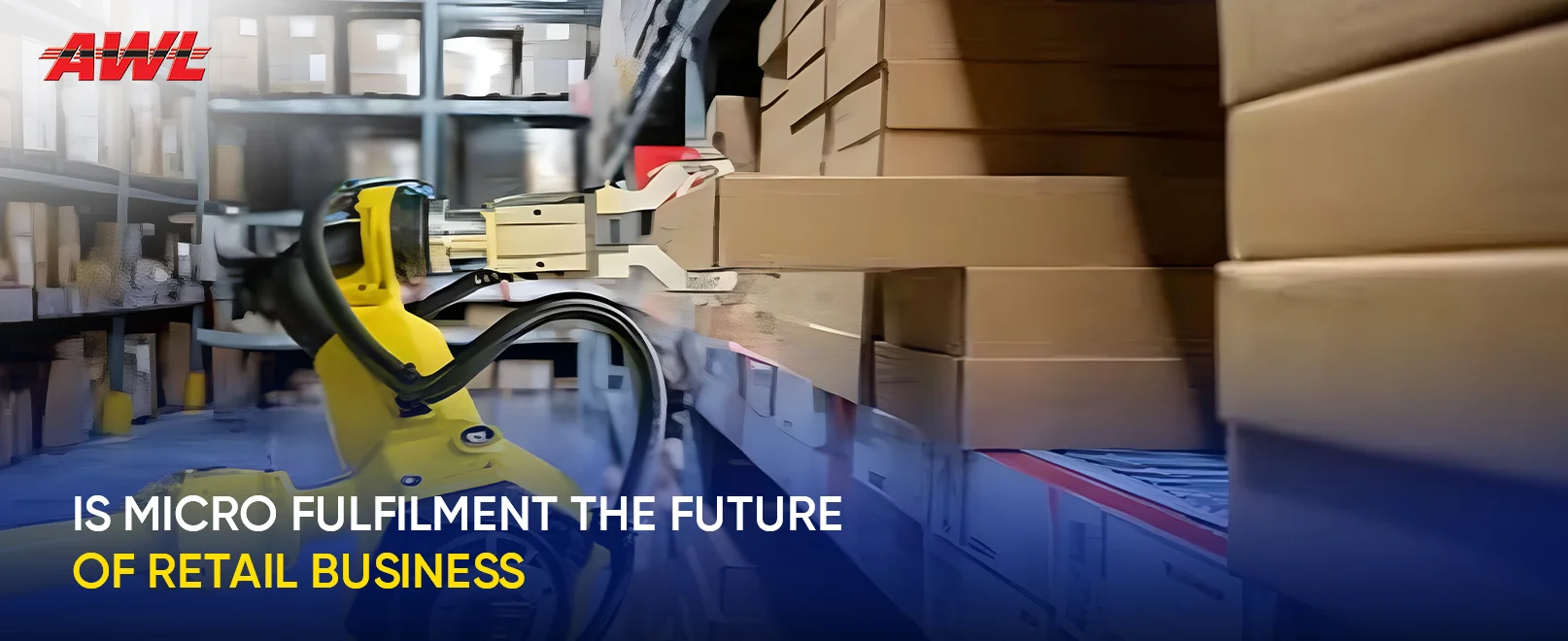
In the era of consumerism, where instant deliveries have taken over the market, any delay in receiving orders can have consequences for the seller. The competition in the market is evolving day by day. Companies are trying their best to deliver products to their customers at faster rates than their competitors, by applying new strategies. One such strategy is micro fulfilment, which makes the whole process more efficient by setting a small scale warehouse or storage facility usually near densely populated areas or where there is a huge demand. This helps the businesses to reduce the time to fulfil the delivery process.
In today’s time, where same day deliveries are operational in some locations, the big players in the market are still figuring out solutions to uphold customer expectations and maximise their profit margins at the same time. This is where Micro fulfilment comes into the picture and can ease the last mile delivery process. The last mile delivery process, on the other hand, is usually the most time consuming among all the different stages of delivery and makes up to about 40-50% of the total cost of the supply chain. However, micro fulfilment can minimise this cost as it reduces the shipping costs from central distribution centres to the local delivery areas.
What is a Micro Fulfilment Centre?
Fully or semi-automated centres usually situated near the end consumer is known as a micro fulfilment centre. They are also known as dark stores and usually cover an area between 3,000 to 10,000 sq.ft. These centres can either be a part of a large warehouse facility or can even be an individual unit. Micro fulfilment centres are responsible for the processing and packing of orders with minimal human interaction by using automation techniques. A micro fulfilment centre is usually stocked with limited inventory that can last from anywhere between 24 to 72 hours and needs to be refilled thereafter. These centres are liable for deliveries of orders that are placed within a specific pincode. Orders can then be executed within a very short span of time and also reduce the cost of carrying out the delivery process. Micro fulfilment centres can also enable you to fulfil same day deliveries and thus help in increasing customer satisfaction.
Micro Fulfilment Centres Boosting Retail Efficiency
By establishing these micro fulfilment centres, the sole purpose of every business is to match up to the needs of the end consumer. Despite having fully automated solutions, it is still very difficult to achieve the required efficiency for these fulfilment centres. Moreover, there are various areas where you can benefit from these micro fulfilment centres. Some of those areas are as follows:
Improving Analytics
Micro fulfilment warehouses enable companies to develop deeper insights into the purchasing patterns of customers of a smaller area, usually within the same pincode. This can help in improving the analytics and enable the company to store the inventory according to user’s requirements to make order pickups more quick and cost effective.
Faster Order Fulfillments
Micro fulfilment centres are generally either fully or semi-automated, which helps in reducing the time to complete the order fulfilment process. The orders can now be picked from a relatively smaller area, also increasing the order accuracy at the same time. According to a report, the pick up process in a regional distribution centre takes around 60 minutes which is much higher as compared to the time taken in micro fulfilment centres that is 6 minutes.
Faster Delivery Process & Ease of Integration
Micro fulfilment centres are much smaller in size as compared to traditional warehouses. Therefore, they can assist in the company’s expansion since they can enable the business to reach a larger area and easily integrate into the existing supply chain. Also, it reduces the delivery time and saving cost at the last mile delivery process of an ecommerce company.
Benefits of Micro Fulfilment Centres
As per traditional warehousing, a business needs a larger capital investment to earn sales numbers and generate revenue from the business. However, a large number of companies today are focusing on a faster fulfilment process, where micro fulfilment centres can act as a game changer for them. Moreover, there are numerous ways in which a micro fulfilment centre is better than traditional warehousing. Some of those ways are as follows:
Responsive to Change in Customer Demands
Micro fulfilment centres are much more responsive to adapt to the change in customer demands as compared to the traditional warehouses. If under any circumstance, there is a change in the customer demand of a particular area, then switching the inventory inside a micro fulfilment centre can be much more efficient and easy as compared to the traditional warehouse.
Customisable Products
Micro fulfilment centres provide much more accurate analytics and enable the business to get a better picture of the customer demands. Micro fulfilment centres can optimise the customer demand and stock up the required inventory to ensure a much faster and efficient order fulfilment process.
Quality Control
Where there are less number of products, it is comparatively easier to maintain the quality of the products that are being delivered to the customers. This is much more difficult in traditional warehouses as they have a number of goods stored inside them.
Faster delivery time
Usually, it can be observed that the commercial vehicles can only enter city limits after a certain time, which ends up in creating long traffic jams at the city borders. Micro fulfilment centres can reduce this hassle and are set up near the end consumer thus, reducing the travelling distance which helps in ensuring extremely faster deliveries to the customer.
Lower Set up & Operational Costs
Traditional warehouses can be an extremely expensive set up and involves a much higher level of risk. Whereas a micro fulfilment centre, on the other hand, takes much less time and cost to set up. Along with that, the operational costs are much lower than traditional fulfilment centres which in turn helps the companies to improve their profit margins.
Key Challenges Faced By Micro Fulfilment Centres
It can be assumed that micro fulfilment centres can be the best thing to happen in the whole supply chain process and have the potential to revolutionise the whole logistics industry. However, there are certain challenges that are being faced by these facilities today. Therefore, if you are planning to set up a micro fulfilment centre, then it is important for you to keep these challenges in mind before setting up your project. Some of the key challenges are as follows:
Constant Inventory Replenishment
Due to the small size of a micro fulfilment centre, then inventory needs to be replenished more often. However, in order to overcome this challenge, it is important to have a proactive inventory replenishment system. By doing so, you can enable yourself to maintain your inventory levels in accordance with the customer demands.
Unpredictability of The Consumer
Sudden changes in the market trends are unpredictable which makes it difficult at times to quickly adapt to a certain market trend. Market trends can change overnight resulting in the demand of an unexpected product the next morning. Adapting with these changes is necessary to stay competitive in the market and maintain your profit levels.
Stockout Risks
The inventory levels at micro fulfilment centres are usually very limited and there is a constant risk of running out of stock. Unpredictable high demands can cause stockouts to happen more frequently. Maintaining proper SKU levels can save you from this challenge.
Order Consolidation
Multiple items in a single order can be difficult to fulfil at a micro fulfilment centre, if even one of the items is out of stock as all the items are to be delivered together. Along with that, it can also lead to a delay in the delivery of the order or even cancellation in the worst case scenario. This can affect the customer satisfaction level and can lead to mistrust of the whole system.
Not suitable for all products/SKUs
Micro fulfilment centres are usually small in size and might not be suitable for products that cover more areas. These products can be difficult to maintain within a limited space available and the company might have to make a sacrifice on being able to sell certain products.
How Can You Utilise Micro Fulfilment Centres
A micro fulfilment warehouse can cater a variety of retail categories, including grocery, drug, general merchandise and other departmental stores. Micro fulfilment centres can be used in the back of an existing store and are run directly by the merchant. On the other hand, a business can establish a stand alone centre and rent out spaces to other retailers. In such a case, the company that installs the fulfilment centre is usually the one who runs it. Therefore, in order to utilise micro fulfilment centres it is important to discover your demands and then strategize the micro fulfilment centre accordingly. You can utilise a micro fulfilment centre to save on time and cost to run the supply chain operations for your business.

John Smith
Digital Tech Head
